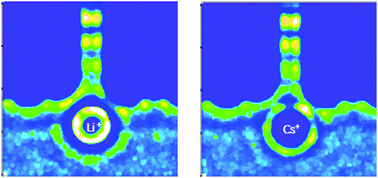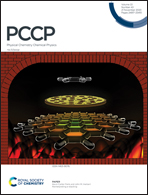Selective adsorption of monovalent cations in porous electrodes
Abstract
To clarify the mechanisms involved in the electrochemical adsorption of ions of aqueous electrolytes in porous electrodes, we performed molecular dynamics simulations of systems composed of porous carbon electrodes with various pore sizes and aqueous solutions containing a Li+, Na+, K+, or Cs+ cation and a Cl− anion. The free energy barrier preventing the cation from entering the pore in the electrode and the hydration structure around the cation were calculated for each cation species and each pore size of the electrode. As the cation moved toward the porous electrode from the bulk electrolyte, rearrangement of the hydration network occurred. The energetic cost of this rearrangement of the hydration network was identified as the cause of the free energy barrier. We estimated the likelihood of cations becoming adsorbed by the porous electrode for different pore sizes and applied voltages and found that the specificity of the magnitude of the free energy barrier for different ions is determined by two factors: ion size (Li+ < Na+ < K+ < Cs+) and the strength of hydration (Li+ > Na+ > K+ > Cs+). With no or a low applied voltage, the ion size dominates the selectivity, and with a high applied voltage, the strength of hydration dominates, although there were some exceptions. The ion specificity of the free energy barrier could be utilized in the selective adsorption of ions from multi-component electrolytes by controlling the pore size of the electrode and the applied voltage.



 Please wait while we load your content...
Please wait while we load your content...